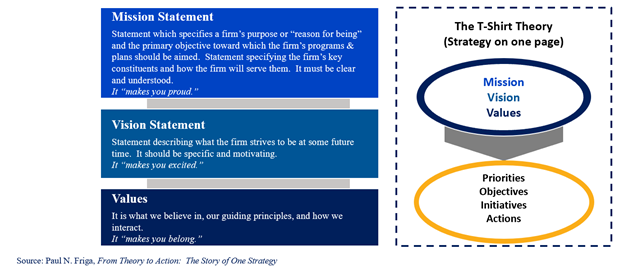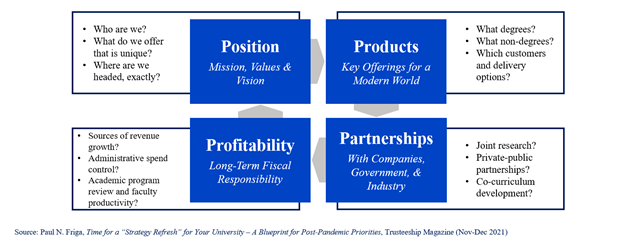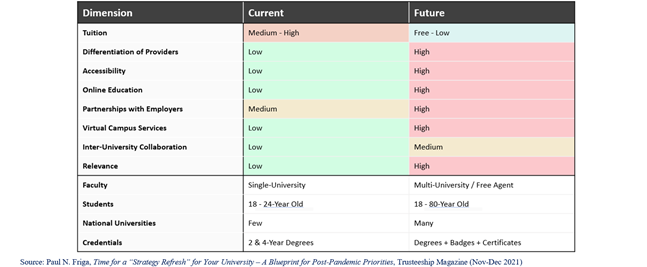
Opinions expressed in AGB blogs are those of the authors and not necessarily those of the institutions that employ them or of AGB.
Paul Friga, PhD, is our AGB Consulting practice area leader for strategic transformation of public higher education and the clinical associate professor of strategy at the Kenan-Flagler School of Business at the University of North Carolina at Chapel Hill.
My framework for this blog on strategy harkens back to 1973 and the “Six Million Dollar Man.” I have to admit, that was one of my favorite shows and if this sounds familiar, we are of a similar genre. Just like Steve Austin, we have a broken model in higher education – “We have the technology. We can rebuild him. Better. Stronger. Faster.”
Better
Strategy is hard but can be straightforward. The goal is to craft clear guidance for decision-making in the organization and to make the value-proposition clear to external constituents, including prospective students, faculty, and staff. There are clear deliverables in terms of strategy statements (mission, vision, and values) that should inform priorities, objectives and initiatives as shown in the slide below.

How can modern strategic planning be better
- Truly seek differentiation in what you do – relying on teaching, research, and service as a mission does not get you there. Find out what is truly special about your institution and important to target constituents and then tell that story over again. I have a database of all the mission and vision statements over the Top 100 universities in the world and there are some great examples out there! But more common are generic statements that sound extremely homogenous and nondifferentiated.
- Focus on strategic vs. operational issues – strategy is not operations. The goal is not to have a laundry list of all the operational activities necessary to run a university. The goal of strategy is to identify and prioritize the most important areas for change. A good SWOT analysis can help with this but use strategy to make trade-offs in activities, based upon an evaluation of the positive long-term impacts toward the stated goals.
- Tackle the hard challenges – shown below is a framework I use to capture the most important topics for boards and cabinets to consider in crafting their strategies today. Times are different for higher education, and we need to adjust what we offer and how we operate. Deep dives into the areas and making appropriate investments are crucial to advance strategies.

Stronger
The strength of strategic planning is measured in several ways. The first is awareness – how many people on campus even really know the strategy? Without recollection, it is quite difficult to positively affect strategic decision-making. Next, is buy-in. A good strategy should appeal to many people as they can see where the institution is headed and understand how their effort contributes to that journey. For today’s employee base, the only way to ensure buy-in is to convince them of the need for change and involve them in the process of determining what we should be doing differently. The days of total top-down strategy are generally behind us. Finally, does the strategy actually change behaviors on campus? Only if it is backed by resource investments that are tied to the stated priorities. One of my favorite models for describing the approach to turn strategy to action is John Kotter’s model of change management which include 8 key steps: (i) Create a Sense of Urgency; (ii) Build a Guiding Coalition; (iii) Form a Strategic Vision; (iv) Enlist a Volunteer Army; (v) Enable Action by Removing Barriers; (vi) Generate Short-Term Wins; (vii) Sustain Acceleration; and (viii) Institute Change.
How can modern strategic planning be stronger
- Craft Strategy “Slogans” – Too many universities have long-winded mission and vision statements that no one on campus can recall or operationalize. Better is to create short, concise, and clear strategy statements that capture the essence of the longer statements and make things more clear. Drill-down levels of additional details are fine but don’t try to put everything in those statements.
- Involve Your Campus in the Strategy Process – The board needs to be involved in the strategy process but should not craft the strategy and push it down. Their role is ask the right questions, agree upon metrics, and hold the campus leadership accountable for progress. The cabinet is responsible for crafting the strategy – with the help of the campus. There are several ways to involve the community in an efficient manner – a SWOT and Strategy Statement Survey (I always start here), Town Halls with electronic feedback and meetings with Faculty Council, Student Council, Alumni Council, and other groups.
- Manage the Change Carefully – the Kotter Model of Change Management is one of the best frameworks out there to describe how to move a university forward. The first three elements are most important – (i) Create a sense of urgency (with data); (ii) Build a Guiding Coalition (shared governance); and (iii) Form a Strategic Vision (typically 3 years out).
Faster
The final aspect of strategic planning that is different in the modern era is the amount of time it takes to complete the process. In the “old days” of higher education, a strategic planning process often takes a year or more and is updated about four-five years later. Now, the macro environment is changing rapidly and so too, should our strategies. I suggest that strategic planning should take no more than 3 months and that the planning period should cover the next three years. Clearly a longer-term vision is important, especially for areas such as the campus master plan and academic program launches, but specific suggestions for priorities, objectives and initiatives should only go out 36 months. Shown below are some of the key elements of higher education that are undergoing transformation right before our very eyes.

How can modern strategic planning be faster?
- Shorten the strategic planning period – Set very specific timelines and efficiently manage the strategic planning process. Best practice is to complete the process in three months – but this requires carefully planning and multiple workstreams simultaneously. Also essential is constant communication – with a strategic planning website that keeps the community updated and allows for full and anonymous inputs. External facilitation is recommended as that allows the cabinet to fully engaged on the content with less time dedicated to project management.
- Keep the planning horizon to three years – Too many things are changing in higher education to allow a 5 to 10-year planning timeline. Of course, long-term assumptions are needed but every three years, there should be at least a strategy refresh of the priorities and initiatives (hopefully the mission and vision do not need to be revised every three years).
- Think of strategy as a living document – The goal of strategic planning is to produce a strategy that helps those within the institution make decisions with resource allocations that are aligned to moving forward toward the vision. Once the strategy is set and goals established, the university moves to execution and reports out on progress on a regular basis and course corrects as they go.
Help from AGB.
I am the AGB Consulting practice area leader for Strategic Transformation of Public Higher Education and stand by to review your current strategic plan, identify your market differentiation and consider ways to invest according to key priorities. I am available to schedule an hour call, at no cost, to review your situation — just email me at pfriga@agb.org.
Here is an article that I wrote on tips for a better, stronger and faster strategy in AGB’s Trusteeship Magazine – Time for a “Strategy Refresh” for Your University. Here is a related Blog that I wrote for AGB that may also be helpful – Don’t Forget Long-Term Strategy.
Given the urgency of the times, I am hosting a special AGB monthly workshop program on “Strategic Transformation” exclusively for board members and presidents. Our next workshop is directly related to this topic, and we are featuring the one of the most action oriented and modern planning examples in the country – Indian River State College and will be interviewing President Timothy Moore. You can register for the February 23 2:00-3:30 pm workshop on “Modern Strategic Planning” here.
Paul Friga, PhD, is our AGB Consulting practice area leader for strategic transformation of public higher education and the clinical associate professor of strategy at the Kenan-Flagler School of Business at the University of North Carolina at Chapel Hill.


